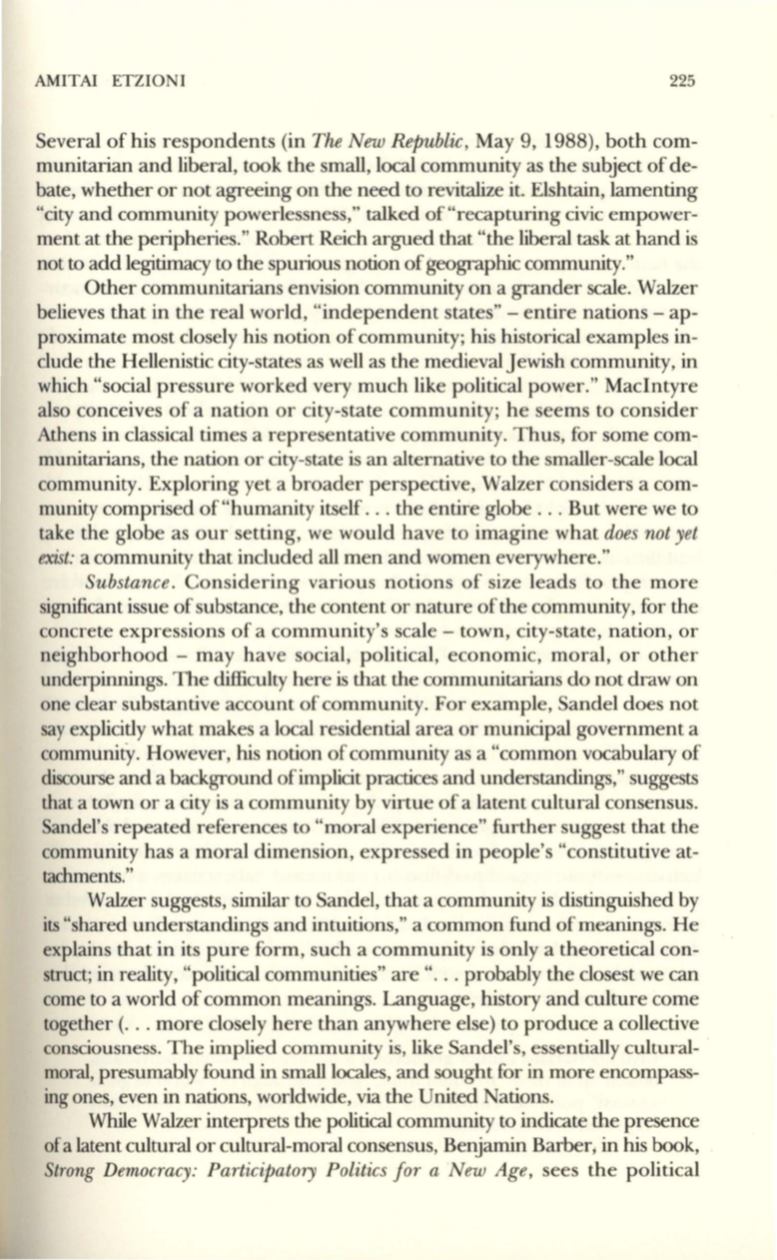
AMITAI ETZIONI
225
Several of his respondents (in
The New Republic,
May 9, 1988), both com–
munitarian and liberal, took the small, local community as the subject of de–
bate, whether or not agreeing on the need to revitalize it. Elshtain, lamenting
"city and community powerlessness," talked of "recapturing civic empower–
ment at the peripheries." Robert Reich argued that "the liberal task at hand is
not to add legitimacy to the spurious notion ofgeographic community."
Other communitarians envision community on a grander scale. Walzer
believes that in the real world, "independent states" - entire nations - ap–
proximate most closely his notion of community; his historical examples in–
clude the Hellenistic city-states as well as the medieval Jewish community, in
which "social pressure worked very much like political power." MacIntyre
also conceives of a nation or city-state community; he seems to consider
Athens in classical times a representative community. Thus, for some com–
munitarians, the nation or city-state is an alternative to the smaller-scale local
community. Exploring yet a broader perspective, Walzer considers a com–
munity comprised of "humanity itself . .. the entire globe .. . But were we to
take the globe as our setting, we would have to imagine what
does not yet
exist:
a community that included all men and women everywhere."
Substance.
Considering various notions of size leads to the more
significant issue of substance, the content or nature of the community, for the
concrete expressions of a community's scale - town, city-state, nation, or
neighborhood - may have social, political, economic, moral, or other
underpinnings. The difficulty here is that the communitarians do not draw on
one clear substantive account of community. For example, Sandel does not
say
explicitly what makes a local residential area or municipal government a
communitY. However, his notion of community as a "common vocabulary of
discourse and a background of implicit practices and understandings," suggests
that a town or a city is a community by virtue of a latent cultural consensus.
Sandel's repeated references to "moral experience" further suggest that the
community has a moral dimension , expressed in people's "constitutive at–
tachments."
Walzer suggests, similar to Sandel, that a community is distinguished by
its "shared understandings and intuitions," a common fund of meanings. He
explains that in its pure form, such a community is only a theoretical con–
struct; in reality, "political communities" are "... probably the closest we can
come to a world of common meanings. Language, history and culture come
together (.. . more closely here than anywhere else) to produce a collective
consciousness. The implied community is, like Sandel's, essentially cultural–
moral, presumably found in small locales, and sought for in more encompass–
ing ones, even in nations, worldwide, via the United Nations.
While Walzer interprets the political community to indicate the presence
ofa latent cultural or cultural-moral consensus, Benjamin Barber, in his book,
Strong Democracy: Participatory Politics for a N ew Age,
sees the political


